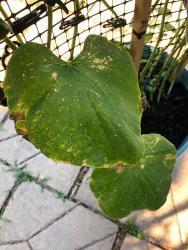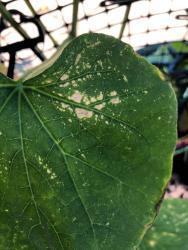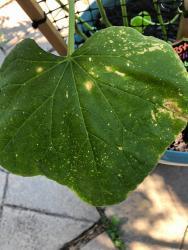Any help would be greatly appreciated. We are growing our pickling cucumbers in containers/with trellises this year and picked Boston Pickling Cucumbers and Titus F1 Pickling Cucumbers. We follow a pretty structured watering and feeding/soil amendment schedule. Things have been going well.
My most mature container of Boston Pickling cucumbers was doing great and loving it's trellis. All of the sudden last week, the plants started to VERY rapidly deteriorate. I noticed very small yellowish spotting on the leaves, and started studying what it could be. By later that afternoon, the bottom-most leaves on every plant in that container had even more spotting, edges were yellowing and deteriorating and were really, really drooping and wilting. Nothing wrong with the vines at all. *I did look at dozens of photos and watched some videos from trusted sources. I noticed definite signs of tiny chew marks on the underside of the leaves as well. The symptoms really matched the damage done by Spider Mites, with a possible bit of mildew. So, I started treating the plants with Neem Oil (top and underside of leaves, pretty much coating entire plant).
Since then, the leaves are NOT wilted and drooping like they were. That part is better. But now, I'm left with a lot of residual spotting and brown, dried out edges. I'm now wondering if the problem is both Spider Mites AND angular leaf spot. So I've been rotating the Need Oil with a copper based fungicide (i rotate them but only apply one or the other every 3ish days). When I try to research, it seems that my plants match the photos for several different possible problems, both fungal and pest related. I don't know if what I'm seeing now is just the damage resulting from Spider Mites, or if there's something else going on (like angular leaf spot). ANY help would be appreciated! Thank you all so much!







